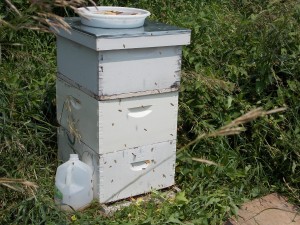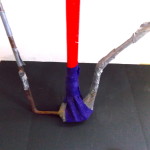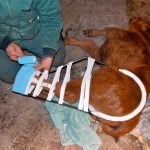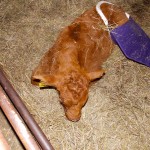 It's quiet when I work with the bees, I work alone. Every move is choreographed ahead of time. The bee suit is too hot, the veil makes my head sweat, and I will NEVER wear gloves again. So, I wear shorts, a t-shirt, and worn out tennis shoes. I'm not brave, actually I'm afraid of getting stung, but with everything you enjoy there are consequences. Getting stung is one of them.
It's quiet when I work with the bees, I work alone. Every move is choreographed ahead of time. The bee suit is too hot, the veil makes my head sweat, and I will NEVER wear gloves again. So, I wear shorts, a t-shirt, and worn out tennis shoes. I'm not brave, actually I'm afraid of getting stung, but with everything you enjoy there are consequences. Getting stung is one of them.

The best weapon is a calm attitude and a heavy plume from the smoker. One of my hives isn't as strong as the others. I had to re-queen it. Earlier in the spring I was installing a second package of bees and I made a mistake. I lost the queen. Well, she wasn't really lost, she flew away. Worried about getting stung, I wore a full bee suit complete with thick gloves. After shaking the bees into the hive body I got the queen cage ready. I carefully removed the plug end and stuffed a mini marshmallow into the opening. I placed my gloved finger over the opening and moved two frames apart, hung the cage, and removed my finger. Looking down I noticed the marshmallow stuck to the glove, "Damn!" I tried to push it back into the cage, but before I could get it back into the opening the queen moved to the end and lifted herself into the air, "Damn, damn, damn!" I watched, dumbfounded, as she flew higher and higher until she disappeared from sight. I let out a desperate cry, "Oh no. Stupid marshmallow!" I thought, there goes my queen, $90.00 just flew away because I was afraid of getting stung. Fear, a glove, and a mini-marshmallow brought my hive's production to a halt.
We covered this in beekeeping class. The instruction was very clear; "If your queen escapes stay very still. She won't recognize her new surroundings. She won't know the bee yard, or hive. She doesn't know the workers, who've surrounded her cage on her trip north, they only met a day ago. Sometimes, if you're lucky, she'll fly in a circle taking a mental picture of the area. The queen will view you, the beekeeper, as a fixture of that area. In her mental picture you belong where she belongs. It's very important to remain still and leave everything as it was when she flew off."
I waited. No queen in sight. Two minutes - no queen. Three minutes, still no queen. Five minutes, no queen, just sweat running into my eyes and trickling down my back. Bee suits are incredibly hot. Keith was headed to town. He saw me standing still in this ridiculous outfit and called from the truck, "Hey, was there a nuclear accident at the plant?" he laughed and drove off. I'd have given him the finger, the gloved one with the marshmallow stuck to it, but I was standing perfectly still waiting for the queen's return. Lucky for him I couldn't move for a few more minutes. After ten minutes I gave up. I remembered one last piece of advice from class, "Never, EVER, let your queen escape." If she does its goodbye, queen!





 It was time for an up-grade, so this year we're growing two varieties of organic Oyster mushrooms; Grey Dove and PoHu.
It was time for an up-grade, so this year we're growing two varieties of organic Oyster mushrooms; Grey Dove and PoHu.












 Every now and again I have a bad day on the road. A couple of months ago my beautiful drive in the country turned ugly. I had three flat tires; one blow out, one flat, and a nail sticking out of the sidewall of the third tire. With the tires fixed I was back on the road. A few miles later the alternator failed. It wasn't a great day.
Every now and again I have a bad day on the road. A couple of months ago my beautiful drive in the country turned ugly. I had three flat tires; one blow out, one flat, and a nail sticking out of the sidewall of the third tire. With the tires fixed I was back on the road. A few miles later the alternator failed. It wasn't a great day.




 And now, another lesson from a very
And now, another lesson from a very  Using an old window screen, placed over the hive body, I dump a pound of powdered sugar on top. It's important to have the smoker ready to force the bees away from the screen. Using a bee brush to gently spread the sugar across the screen so it falls between the frames, I continue to apply smoke. You don't want the bees clinging to the screen because the brush will damage the bee's legs, sometimes amputating them.
Using an old window screen, placed over the hive body, I dump a pound of powdered sugar on top. It's important to have the smoker ready to force the bees away from the screen. Using a bee brush to gently spread the sugar across the screen so it falls between the frames, I continue to apply smoke. You don't want the bees clinging to the screen because the brush will damage the bee's legs, sometimes amputating them.


 The oak tree along the lane is dropping bushels of acorn that go uncollected. The oak in the pasture is dropping a heavy crop for the pigs to feast on. They've gleaned the fallen nuts leaving the ground underneath bare. One pig in particular stands sentry, he won't let the sheep near the tree. He doesn't realize the sheep want sweet clover not bitter acorns. Between the pumpkins, clovers, apples, and nuts the pigs diet is diverse. Their commercial feed goes untouched when there's so much they can harvest themselves. This is one of the benefits of
The oak tree along the lane is dropping bushels of acorn that go uncollected. The oak in the pasture is dropping a heavy crop for the pigs to feast on. They've gleaned the fallen nuts leaving the ground underneath bare. One pig in particular stands sentry, he won't let the sheep near the tree. He doesn't realize the sheep want sweet clover not bitter acorns. Between the pumpkins, clovers, apples, and nuts the pigs diet is diverse. Their commercial feed goes untouched when there's so much they can harvest themselves. This is one of the benefits of 




